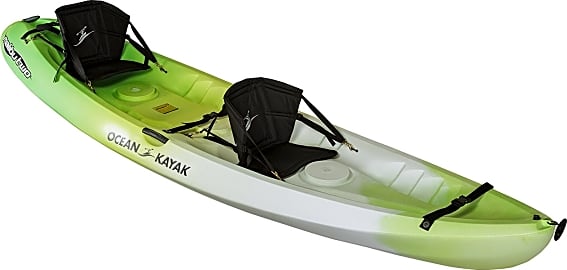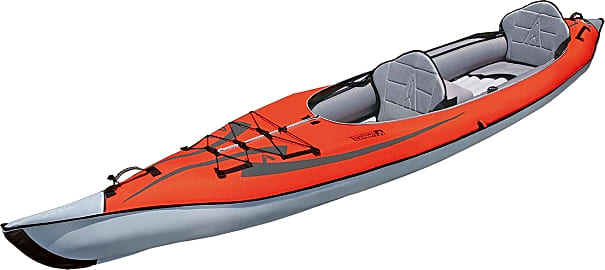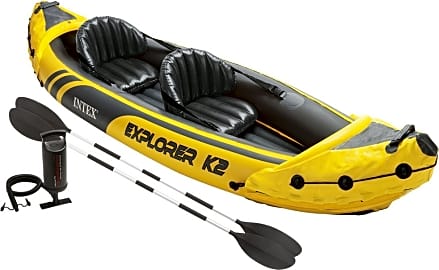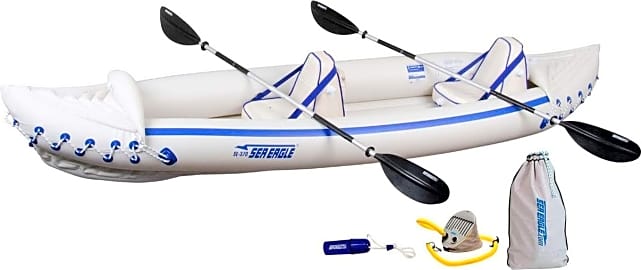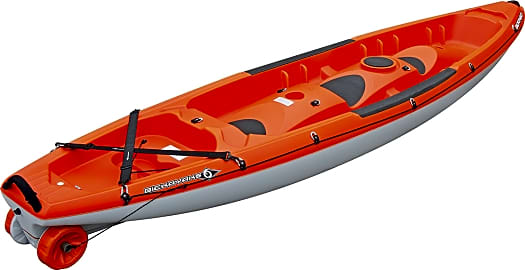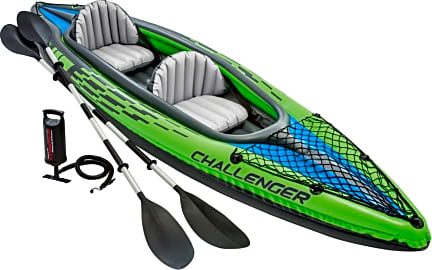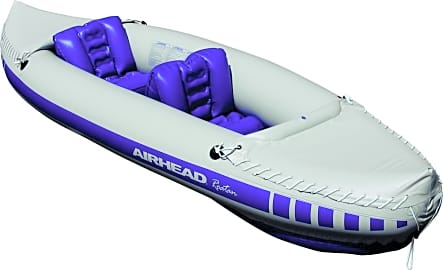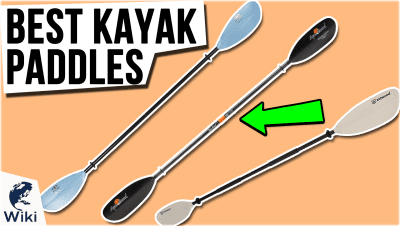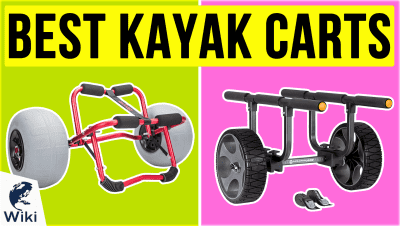The 10 Best 2 Person Kayaks

This wiki has been updated 35 times since it was first published in January of 2016. Whatever adventure you are planning, one may be fun, but two is always better – so take along your partner or a friend on your next aquatic excursion in one of these 2-person kayaks. Our selection has affordable tandem models that are good for all sorts of recreational uses, including easy-to-transport inflatable options and sturdier craft than can handle rough river rapids. When users buy our independently chosen editorial recommendations, we may earn commissions to help fund the Wiki.
Editor's Notes
October 30, 2020:
In adding new kayaks to our list, the Airhead Roatan was an easy choice as it replaces the previous model at a similar cost and has better features. These include sprayhoods at the bow and stern to keep your gear protected from the elements, but this means that space is slightly compromised, meaning that it suits a parent and child more than two large adults.
The unique hull configuration on the Lifetime Kokanee is similar to the old Lifetime model, but it is available with an updated seating arrangement that allows one person to fit the seat right in the center of the kayak for improved power and control. The addition of scuppers that allow rain or seawater to easily drain away is another feature that any owner will appreciate.
April 12, 2019:
When searching for the best 2-person kayak we evaluated hard and inflatable options to satisfy both the serious boater and the occasional user who may not have the means to transport a large vessel.
The Elkton Outdoors took the top spot for having a tough mold-injected body with a high 650 pound weight capacity so that it can comfortably hold 2 adults. But the inflatable choices on the list like Intex Challenger are not mere pool toys, they are made with puncture-resistant materials and will last for multiple seasons.
Finding The Perfect Tandem Kayak
As for which type of kayak is ultimately best, solid or inflatable, that is an individual choice that comes down to storage and portability as much as material.
Not only is kayaking a thrilling activity that is a great way to explore and observe beautiful parts of the world while getting superlative exercise, but it's also a hobby that is remarkably affordable given the low cost of many modern kayaks. And that's true not only for single person boats, but for tandem kayaks as well.
Amazingly, you can own a two person kayak -- and one that comes with paddles, no less -- for under one hundred dollars. In fact, in the inflatable kayak category, there are many such options available in that pleasantly low price range. And if your budget ranges from between one hundred to two hundred dollars, you can get two person inflatable kayaks suitable for everything from enjoying a slow paced trip across the flat water of a lake or slow river, a craft perfect for cruising across the chop of an bay or estuary, or even a tandem kayak suitable for riding the rapids during a whitewater adventure.
The inflatable kayaks of the day are almost as durable as kayaks made from rigid materials like plastic or fiberglass, and are more than suitable for use under myriad circumstances, even for use in waterways where scrapes with rocks or submerged logs are possible. If you plan to take an inflatable kayak into such circumstances, make sure you choose a kayak with multiple air chambers sealed by separate valves. Such boats will not deflate (and sink) even if one pocket of air is punctured, and can therefore safely bring you and your fellow crew member back to shore for kayak repairs or replacement.
If you want a kayak that may well be a lifelong purchase, then turning to a solid bodied boat is likely the better idea. Whether you choose a kayak designed for paddling in the ocean, which are usually large, long, and stable and feature a sit on top design (save for in seawater that tends to be frigid, when a sit-in kayak complete with a sealing skirt is ideal), or you pick a sit in kayak made for navigating the roiling waters of a swift river, a solid kayak is a great choice for all reason save price. These kayaks tend to be more than two or even three times the cost of inflatables, though indeed their longevity can compensate for the expense.
And while of course the type water in which you will use your kayak must play a large role in informing which boat suits you, so too will the type of activities for which you hope to use the tandem kayak. Kayaks suitable for fishing or even for hunting, for example, must be relatively wide and stable. These boats are not designed for speed, but instead for reliably even tracking with minimal rocking.
As for which type of kayak is ultimately best, solid or inflatable, that is an individual choice that comes down to storage and portability as much as material. For while a solid bodies kayak is made to last for years and handles responsible, good luck getting one to fit in the trunk of a car or to be stored in a closet or under a bed.
Other Items Needed For A Great Kayak Adventure
Owning a kayak promises to add fun and excitement to your life, but you will need a bit more gear to ensure that your time spent on the water is both as safe and enjoyable as possible. First of all, you will of course need a good kayak paddle to help you control your nimble watercraft. Even if your kayak came with a paddle, you need to make sure you are using the right paddle for your body in order to enjoy the boat properly.
Finally, and especially if you are kayaking through rapids and among rocks or near riverbanks with overhanging obstacles, its prudent to wear a helmet while kayaking.
As a quick reference guide, for shorter paddlers (those around five feet in height), a paddle measuring around 190 centimeters at most is deal. For someone standing around 5'6", a paddle that is a bit longer, at 195 centimeters is fine choice. And for those standing taller than six feet, a paddle larger than 200 centimeters is best. (Note that kayak paddle measurements always use the metric system.)
Next on the list of must-haves is a good life vest. And do use a vest style personal flotation device, one that can be secured comfortably around your torso without riding up around your neck, to maintain easy, unrestricted motion of your upper body.
Finally, and especially if you are kayaking through rapids and among rocks or near riverbanks with overhanging obstacles, its prudent to wear a helmet while kayaking. Most helmets designed for use while participating in water sports are lightweight and comfortable, and more than worth their expense the first time they save you from a head injury (which can commonly be caused by the hull of your own kayak).
The Brief History Of The Modern Kayak
Save for the materials used in construction, modern kayaks don't look much different than their predecessors from centuries past. The basic shape of a kayak -- what with its sleek, angular hull, its center of gravity low in the water, and its high, often enclosed walls crafted to keep water at bay -- had already achieved a point of design pinnacle hundreds if not thousands of years back. The only real "improvements" modern kayaks have over their ancient forebears is the quickness of ease of construction as well as a bit of durability that seal skin and whale bones can't match in blow molded plastics.
Well into the second half of the 19th Century, most of the world's kayaks were still made from the age old materials including skin covers and frames made from bone or wood (which was scarce in the frigid northlands). Toward the turn of the last century, craftsmen began to make kayaks using fabrics such as treated canvas stretched over wooden frames. Kayaks carved from wood were also common (and lovely, though time consuming to create and prone to damage in many circumstances.)
In the mid 20th Century, fiberglass kayaks became popular, soon dominating the market. Relatively lightweight, highly hydrodynamic, and easy to mass produce, this design reigned for several decades until advances in the formula of and molding techniques using polyethylene plastics made molded kayaks even easier to produce than fiberglass boats.


